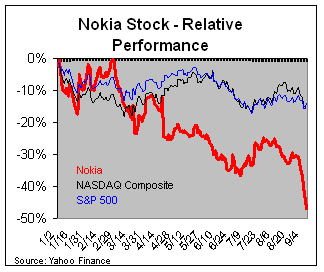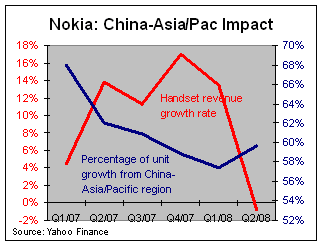Nokia’s Emerging Problems
Folks surprised by Nokia’s recent market share warning just haven’t been paying attention
September 16, 2008

Recently there has been a fair amount of wailing and gnashing of teeth after Nokia Corp. (NYSE: NOK) announced that its market share was likely to decline in the September quarter.
If you take a look at the following two graphs you can see quite readily that Nokia’s stock price has taken a beating thus far in 2008 on an absolute and relative basis. But despite the recent surprise for many investors, the reality is such that the seeds of Nokia’s problems were sown a while ago.
 To begin with, Nokia doesn’t provide anything that you could actually call “guidance” on its quarterly conference calls. Many companies will give their best estimates as to revenue and EPS, whereas some will even attempt to provide expectations on margins and tax rates. Hey, the more information the better, and – while we know that these are “forward looking statements” subject to change – it’s helpful from an investment perspective to at least know what the management is thinking and what its based upon. Nokia only provides an estimate as to how much it thinks the handset industry will grow in the upcoming quarter combined with its estimate as to what will happen to its own market share.
To begin with, Nokia doesn’t provide anything that you could actually call “guidance” on its quarterly conference calls. Many companies will give their best estimates as to revenue and EPS, whereas some will even attempt to provide expectations on margins and tax rates. Hey, the more information the better, and – while we know that these are “forward looking statements” subject to change – it’s helpful from an investment perspective to at least know what the management is thinking and what its based upon. Nokia only provides an estimate as to how much it thinks the handset industry will grow in the upcoming quarter combined with its estimate as to what will happen to its own market share.
Consequently, when Nokia said its market share would decline, rather than remain flat, the company was announcing that the rest of those numbers (little things like revenue and earnings) were below its internal plan.
The graph below displays two disparate but related data points. First and foremost, it shows that the handset revenue growth rate (red) has declined in the last two quarters. That’s a year-to-year growth rate, so we’re not looking at a seasonality factor.
The other line (blue) shows the percentage of unit growth (trailing twelve months) coming from the China and Asia/Pacific regions. I’ve said many times that the industry’s growth is a function of emerging markets, and this shows quite well that these two emerging markets were consistently generating about 60 percent of the company’s unit growth. The problem is that the company’s European markets used to fairly consistently represent 20 to 25 percent of Nokia’s unit growth. That’s been declining and in the most recent quarter was only 10 percent of the units. Handsets sold into the European markets are generally higher-end and carry higher ASPs.
The problem is that the company’s European markets used to fairly consistently represent 20 to 25 percent of Nokia’s unit growth. That’s been declining and in the most recent quarter was only 10 percent of the units. Handsets sold into the European markets are generally higher-end and carry higher ASPs.
To Page 2
With the China-Asia/Pacific regions continuing to generate the bulk of the unit growth (now supplemented by Africa-Middle East), Nokia is seeing ASP compression. The evidence for this is displayed quite dramatically by the table below. Despite the huge unit growth rates taking place in these regions, they are largely unchanged as a percentage of Nokia’s total revenue over the last six quarters. This situation would not be happening if there were not a significant differential in the ASPs of these regions versus others. Now, realistically, there’s only one way for this situation to get worse at this point, and that’s if we see a general slowdown in handset growth rates either through lost market share or industry growth slowing. While Nokia cited lost market share in its press release, the implication was that it had more to do with pricing pressure on entry-level and some mid-range phones. The willingness to pass on the pricing game is interesting, given the fact that Nokia has the lowest cost basis in the industry. However, what it may also suggest is that part of the problem is at the opposite end of the spectrum.
Now, realistically, there’s only one way for this situation to get worse at this point, and that’s if we see a general slowdown in handset growth rates either through lost market share or industry growth slowing. While Nokia cited lost market share in its press release, the implication was that it had more to do with pricing pressure on entry-level and some mid-range phones. The willingness to pass on the pricing game is interesting, given the fact that Nokia has the lowest cost basis in the industry. However, what it may also suggest is that part of the problem is at the opposite end of the spectrum.
Obviously, every company with a broad product line uses higher-margin phones to offset the lower-margin units in hopes of keeping the customers and shareholders happy. If your higher-margin units aren’t doing as well as expected, you’ve got a problem. And its no secret that, love it or hate it, the iPhone 3G launch this summer was fairly successful. It’s hard not to believe that many of those new iPhone 3G customers may well have been former Nokia customers.
The market share issue aside, there may be an even bigger reason to be concerned. High unit growth in a low ASP market is at least high unit growth. What happens if unit growth slows?
I have showed the graph below a number of times as a proxy for emerging market subscriber growth. It’s updated with the data through July of this year. While the “spike” up in March is an anomaly (TRAI requiring subscriber confirmation in 2007), what’s troubling is the steady fall-off in growth over the last three months. What had been fairly consistent (median = 31%) new subscriber growth for more than a year dropped to the high 20s, then the low 20s and most recently 12 percent. With China (8+% subscriber growth in July) we know there are mitigating factors: first the earthquake; then the industry’s restructuring; and the lead-up to the Olympics. However, India (14+% subscriber growth in July) experienced no such issues. That raises the question of how much of this weakness is cyclical?
With China (8+% subscriber growth in July) we know there are mitigating factors: first the earthquake; then the industry’s restructuring; and the lead-up to the Olympics. However, India (14+% subscriber growth in July) experienced no such issues. That raises the question of how much of this weakness is cyclical?
The August numbers will certainly be weak in China, and the restructuring will take several more months to iron out. Consequently, Nokia appears to be rowing a leaky boat, to say the least.
The only possible silver lining in this dark cloud is the potential for infrastructure spending that will come with the industry restructuring in China. Certainly we’ll see a lot of Renminbi being spent, but, as I have suggested in the past, the bulk of that is likely to go to the home team – Huawei Technologies Co. Ltd. and ZTE Corp. (Shenzhen: 000063; Hong Kong: 0763).
The bottom line here is that Nokia is going to see some tough sledding, and the writing has been on the wall for quite sometime. You only had to look.
— Bob Faulkner, Special to Unstrung
Nokia is one of the many technology and telecom companies that Bob Faulkner writes about weekly in The Telecom Connection.
You May Also Like


_International_Software_Products.jpeg?width=300&auto=webp&quality=80&disable=upscale)







